John Hurrell – 14 November, 2018
There are over eighteen contributors to this unusual show, four of them New Zealanders, and with their artworks the walls between the Wellington ‘art space' and the bigger outside world of global politics (sometimes mingled with fashion and entertainment) seem clearly dissolved. There is an obvious topical vibrancy to this exhibition.
Wellington
Michelangelo Antonioni, Emory Douglas, Marco Fusinato, Johan Grimonprez, Jean-Luc Godard, Giovanni Intra and Michael Parekowhai, Oliver Maxwell, James McTeigue, Maharishi, Dane Mitchell, Monash University, Muslimgauze, Pussy Riot, Michael Stevenson, Varvara Stepanova, Rosemarie Trockel, Jemima Wyman
Iconography of Revolt
Curated by Robert Leonard
28 July - 18 November 2018
In this elegantly laid out exhibition on the ground floor of City Gallery (lots of lovely uncluttered walls), that looks at the connections between acts of extreme political activism and ‘progressive’ iconography absorbed into fashion, printed culture, music, movies and art history, Robert Leonard presents classic images of ‘revolt’—promotional iconographies pitched (mostly) to the young that spurn the values of those who control the army and police, and which (via nostalgic image appropriation and ‘rebellious’ progressive causes) give the finger to authoritarian figures such as parents and teachers.
Extremely rich in range, and full of surprises in detail, this restless, energetic and spectacular exhibition vividly mixes your daily overseas headlines (absorbed before you walk in the gallery door) with twentieth/twenty-first century art history and haute couture—it is hard to separate the three. You might want to separate ‘authentic’ radicality from ‘ersatz’ exploiters trying to milk the youth market, or you might feel that it is all good anyway—and that even commercially driven ‘revolutionary images’ lead to idealism and therefore positive results.
There are over eighteen contributors to this unusual show, four of them New Zealanders, and with their artworks the walls between the Wellington ‘art space’ and the bigger outside world of global politics (sometimes mingled with entertainment and fashion) seem clearly dissolved. There is an obvious topical vibrancy to this exhibition.
Belgian filmmaker, Johan Grimonprez’s 1997 montage Dial H-I-S-T-O-R-Y looks at the history of (pre 9/11) plane hijacking, splicing news film from the earlier stories—mingled with sci-fi movie clips, cartoons, home vids, and documentaries—using a beautiful poetic text (narrated by Willem Dafoe) based on literary quotations, and a gorgeously sumptuous soundtrack. Hypnotic and hard to leave, while also funny and scary, it links up with many other works such as the trailers from Godard and Antonioni films that Leonard provides.
Former Brisbane, now LA artist, Jemima Wyman‘s densely patterned wallpapered walls, Photoshopped photographs, video and three-masked quilted poncho on a mannequin have a strikingly overpowering presence, fascinating because of the intricacy of their unrelenting detail. Certain repeated motifs dominate—like the chevron which refers to Varvara Stepanova‘s athletes’ costumes of 1923, the balaclava recently made re-popular by Pussy Riot, or the Guy Fawkes mask designed by David Lloyd and popularised by James McTeigue’s dystopian thriller V is for Vendetta (2005).
German artist, Rosemarie Trockel presented her machine-knitted balaclavas (1986) in her Greg Burke curated survey in City Gallery in Wellington in 1993, so it is interesting to see them again in a new, even more global, context. The balaclava mask first gained notoriety through news coverage of the Black September attack at the Munich Olympics in 1972. The patterned ‘logos’ used by Trockel and woven into the wool, include hammer and sickle, plus and minus, swastikas, and Playboy Bunnies, demonstrating capitalism’s willingness to take the edge off potentially violent criticism by ‘democratically’ embracing it commercially.
Maharishi is known for its men’s casual fashion garments, being established since 1994. Over 2015-2016 it became known for what is dismissively called ‘jihad chic’ for presenting runway shows of ‘terrorist garb’ in London within days of the Charlie Hebdo killings and hostages taken in a kosher supermarket in Paris. Check out this video.
Oliver Maxwell is a photographer who in the eighties worked for The Face magazine. He is famous for an ambiguous suite of studio images of ‘terrorists’ and ‘soldiers’ with weapons, dressed in the uniforms of nine military organisations involved in the Lebanese Civil War (1975-1990) that appeared in ‘Who’s Shooting Who’, an article from 1986. That they were posed male models was not immediately obvious. The cover caption said: ‘Beirut Fashion: The Trappings of Terror.’
Australian Marco Fusinato has two large works in this show. One is a huge black and white newspaper photograph of a Palestinian woman about to hurl a rock at Israeli soldiers. She is shown in side profile. The other is a banner stretched across the ceiling but which at one end is also tumbling to the floor. The letters at the floor end are decaying and the text reads ‘This Is Not My World.’ The banner is based on a 1976 text by Croatian artist, Željko Jerman, written in developer on photographic paper. Fusinato regularly gets different graphic designers to reformat it for different installations, forty years plus later—changing its look and its context.
Monash University is represented by an unusual student recruiting video with Blaccout, a hiphop soundtrack by A.B.Original. The vid title claims that if you don’t like the world—with all its violence, chaos and injustice—then change it, and that the best way of achieving that is through a tertiary education. The video itself is not so acquiescent to bourgeois norms. The tone of the music, its fiery rhetoric, hints that an armed insurrection might be more effective.
The May ‘68 photo work by Michael Parekowhai and Giovanni Intra celebrating their two birthdays, the shovel/red flag by Dane Mitchell, Michael Stevenson‘s Judd/Hearst bank robbery drawing and Emory Douglas’s Black Panther (“the blood of the pig must flow in the street”) graphics appear to agree, though it is hard to see these four names as one group; they have so very little in common—in ages, politics or ethos. The streets and police of Aotearoa and the streets and police of the United States are very different in terms of lethal potentiality, especially if you are black.
In this show Leonard’s scattershot (but entertaining…for some, not all) selection mixes degrees of authenticity, artist and corporate poses, and game playing, alongside life and death seriousness—laying it out for you (the gallery visitor) to sort through.
John Hurrell


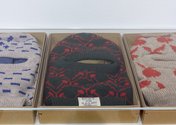
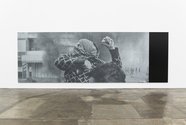
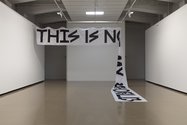



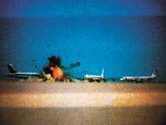

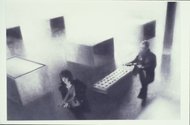
 Two Rooms presents a program of residencies and projects
Two Rooms presents a program of residencies and projects Advertising in this column
Advertising in this column



This Discussion has 0 comments.
Comment
Participate
Register to Participate.
Sign in
Sign in to an existing account.